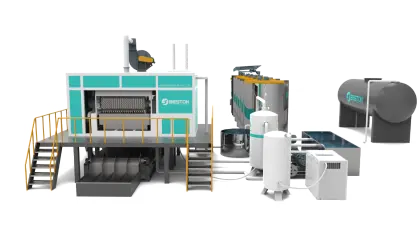Running an egg tray manufacturing plant involves a complex series of processes, from pulp preparation to molding and drying. Like any industrial operation, technical issues can arise, potentially disrupting production and impacting efficiency. Identifying and addressing common issues promptly is crucial to minimize downtime and maintain smooth operations. Below are some of the most frequent problems encountered in egg tray manufacturing plants and suggested solutions.
1. Inconsistent Product Quality
One of the most common issues in an egg tray maker is inconsistent product quality. This can manifest as trays that are too weak, misshapen, or have uneven surfaces. Several factors contribute to this issue:
-
Material Quality: The quality of the raw material, typically recycled paper or pulp, directly affects the final product. If the paper pulp is too wet or too dry, or contains impurities, it may lead to improper molding. Consistency in the pulp mixture is critical for maintaining uniform tray quality.
-
Mold Issues: Worn or damaged molds can produce uneven trays. Regular maintenance and inspection of the molds are essential to ensure they are free from defects that could cause inconsistencies.
-
Temperature and Humidity: Improper drying conditions can also lead to weak or uneven egg trays. The drying area should be controlled to maintain a consistent temperature and humidity level to allow trays to dry properly.
Solution: Ensure that the pulp has the right consistency, inspect the molds regularly for wear, and maintain controlled drying conditions. Using automated systems that monitor pulp consistency and drying parameters can help reduce quality inconsistencies.
2. High Operational Costs
High operational costs are a common concern for egg tray manufacturers, especially when dealing with energy consumption, labor, and material usage. Some of the contributing factors to high costs include:
Energy Consumption: Drying processes, in particular, consume a significant amount of energy. Inefficient drying systems or inconsistent temperature control can lead to excessive energy use.
Wasted Materials: Overuse of raw materials or improper mixing of pulp can result in excess waste, raising the cost per unit of production.
Labor Costs: Manual labor in non-automated sections of the plant can significantly contribute to operational costs.
3. Low Production Efficiency
Low production efficiency is another issue many egg tray manufacturing plants face. This issue could stem from a variety of sources, such as mechanical failures, human error, or inefficient machine settings. Some potential causes include:
-
Clogging or Jamming: The pulp feeding system or molding section may become clogged with excess pulp or debris, causing jams and slowing down production.
-
Poor Machine Calibration: Incorrect machine settings, such as mold pressure, drying time, or pulp thickness, can lead to inefficient production.
-
Underutilization of Resources: Improper workflow and insufficient use of automation can also result in low efficiency, especially when labor-intensive tasks are not optimized.
Solution: Implement a regular maintenance schedule to clean and inspect machines, particularly the pulp feeding and molding sections. Automate as many steps of the production process as possible and ensure that machine settings are calibrated for optimal performance. Employee training on proper operation and machine handling can also help maximize efficiency.
4. Equipment Malfunctions
Frequent equipment malfunctions can lead to significant downtime and lost production time, impacting both output and profitability. Common equipment issues include:
-
Motor Failure: Over time, motors can wear out due to excessive use or improper maintenance. This can disrupt the entire production line.
-
Hydraulic System Issues: The hydraulic systems used in molding and pressing can develop leaks or pressure inconsistencies, leading to poor tray formation.
-
Electrical Failures: Faulty wiring or control system malfunctions can stop the machines from running properly, causing delays.
Solution: Conduct regular inspections and preventative maintenance on all machinery, particularly motors, hydraulic systems, and electrical components. Installing sensors and using predictive maintenance tools can help identify potential failures before they cause significant damage, allowing for timely repairs and reducing the risk of costly breakdowns.
5. Inadequate Drying
Inadequate drying of egg trays is another issue that can significantly affect product quality and production efficiency. Wet trays lead to deformation, weak structures, or mold growth. Inconsistent drying can also slow down the overall production process.
Solution: Ensure that the drying area is equipped with efficient, well-calibrated drying systems. Automated temperature and humidity control systems should be used to maintain a consistent drying environment. Optimizing airflow and using energy-efficient drying technologies can help speed up the drying process while reducing energy consumption.
Conclusion
Troubleshooting common issues in an egg tray manufacturing plant requires a comprehensive approach to maintenance, machine calibration, and process optimization. By addressing key problems such as inconsistent product quality, low production efficiency, high operational costs, and equipment malfunctions, manufacturers can improve both product consistency and overall profitability. Additionally, ensuring that the egg tray manufacturing plant cost remains manageable involves implementing energy-efficient solutions, automating production, and optimizing resource usage. Regular maintenance, coupled with strategic upgrades, can help ensure smooth operations and reduced downtime, leading to a more sustainable and cost-effective production process.



No comments:
Post a Comment